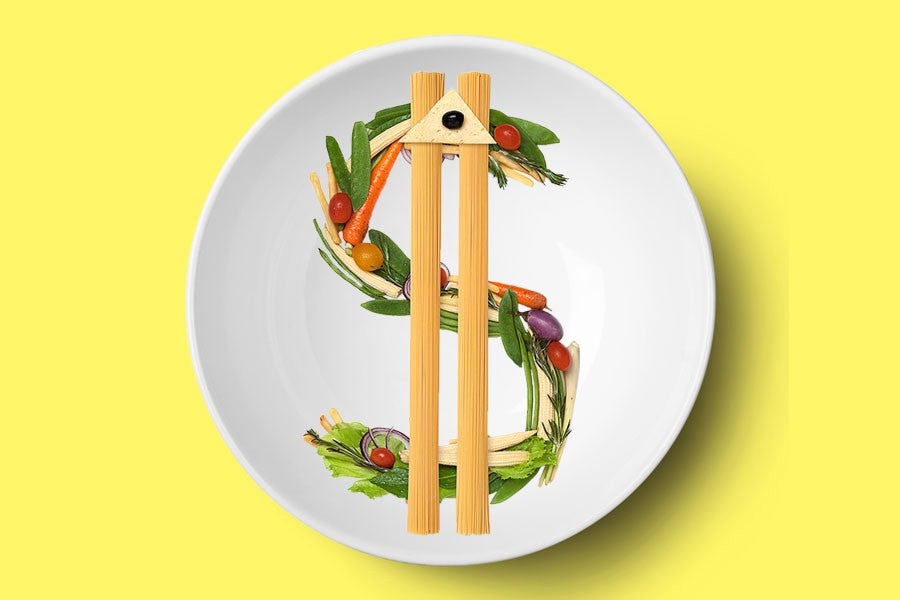You: I should eat healthy.
Whole Foods: We sell organic produce, line-caught fish, specialty nut butters, cold-pressed juices, kombucha, nut milks and other stuff that sounds like it’s going to rebuild your very soul from the purest sunlight!
You: That sounds amazing, can I please get one order of —
Whole Foods: That will be eight bajillion dollars.
You: *cries, heats up Jimmy Dean breakfast sandwich*
We all know it: Eating healthily costs an arm and a leg. But you don’t have to splurge on cleanses and specialty diets to eat well — according to the experts we spoke with, healthy eating can be affordable if you do it right.
Plan Your Meals (And Buy in Bulk)
“Planning your meals is the number one way to minimize grocery costs,” nutritionist Anna Baker explains. “You don’t have to plan every single detail, but going to the store with an idea of the number of meals you plan on cooking — and approximate vegetable, meat and carbohydrate quantities — will prevent you from over-purchasing (and therefore, overspending).”
Another way to save at the store is to buy in bulk. “Grains [rice, oats and pasta] are significantly less expensive when bought in the bulk section of the grocery store,” explains Dana Hunnes, senior dietitian at the Ronald Reagan UCLA Medical Center. “Legumes, like lentils and beans, are also cheaper when purchased dry, then reconstituted (or soaked) at home.”
She’s right: According to The Bean Institute (i.e., my new favorite place), a 1-pound bag of dry pinto beans costs $1.79 on average, whereas a 15-ounce can of pinto beans costs $1.69. (Plus, dry beans can weigh nearly triple their initial weight after being cooked, meaning a one-pound bag of dry beans could produce three pounds — or 48 ounces — of cooked beans.) That means one serving of dry pinto beans costs only 15 cents, versus 34 cents for the canned version.
Bulk buying also applies to pantry staples. “It makes sense to spend a bit more on larger bottles and containers of things that last for a while, like vinegar and olive oil,” says registered dietitian nutritionist Ilana Muhlstein. “Smaller bottles will be more expensive in the long run.”
Go Seasonal (Or Frozen)
“Purchasing in-season produce is another way to save on wholesome and healthy fruits and vegetables, as is buying frozen fruits and vegetables (which are often picked at peak ripeness, then flash frozen),” Hunnes says. “Frozen fruits and vegetables make great, healthy smoothies.”
Frozen fish and chicken are also healthy investments, according to Muhlstein. “These foods are usually pre-frozen anyway — the grocery store just defrosts them, then puts them in the refrigerator for quick shopping,” she explains. “But when you buy frozen, you can save a lot of money. You also can usually find individually-wrapped frozen fillets — that way, you can cook only what you need for the time being, which helps reduce waste.”
Muhlstein also recommends purchasing dried herbs and spices, instead of fresh ones. “Fresh herbs and spices can go bad quickly if you don’t know how to properly store them,” she says. “Dried herbs and spices work well and can be much cheaper.”
Cook in Bulk
“A great way to eat healthy when busy and on a budget is to plan a cooking day,” Baker says. “Take a few hours to cook foods — like healthy soups, nutritious stir fries or wholesome quinoa dishes — in bulk. Then, freeze portions for later in the week, or for next week.” That way, you can quickly warm up a healthy frozen meal instead of swinging through the drive-thru for Naked Chicken Chalupas in a pinch.
Along these same lines, Baker also recommends using leftovers wisely: “Try repurposing your leftovers,” she suggests. “If you’re cooking a bunch of chicken, you can easily toss the leftovers in a salad or a wrap for the next day.”
Keep It Simple in the Kitchen
“A healthy meal is a healthy meal whether it contains five ingredients or 20 ingredients,” Baker explains. “Simple breakfasts (like oats and fruit), easy high-protein salads and basic meat-and-vegetable dinners are all great options containing a minimal number of ingredients.” And the fewer you ingredients you need to purchase, the more money you’ll save.
Ditch the Meat
“Skipping expensive meat and fish is a boon to anyone’s budget,” Hunnes emphasizes. “Opting for plant-based sources of protein (which we need less of than most people realize), like lentils, beans and tofu, is a great way to save some cash. Plus, they’re good sources of fiber, as well as vitamins and minerals that you might not get otherwise.”
Her advice is wise indeed: According to a study published in the Journal of Hunger & Environmental Nutrition, vegetarians can save at least $750 more than meat-eaters per year. Not to mention, the study also found that vegetarian diets are generally more nutritious.
So there you have it: Eating well at a low cost is totally doable, provided you a) spend hours planning your meals in advance; b) garner a full understanding of seasonal produce; c) spend an entire day cooking, then eating leftovers for the rest of the week; and d) change up your diet entirely.
Piece of cake.

